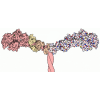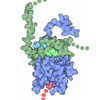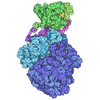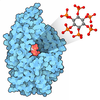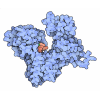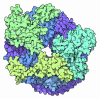+ データを開く
データを開く
- 基本情報
基本情報
| 登録情報 | データベース: PDB / ID: 9nb9 | ||||||
|---|---|---|---|---|---|---|---|
| タイトル | Viral protein DP71L in complex with phosphorylated eIF2alpha (NTD) and protein phosphatase 1A (D64A), stabilized by G-actin/DNAseI | ||||||
 要素 要素 |
| ||||||
 キーワード キーワード | TRANSLATION / Phosphatase / complex / ISR | ||||||
| 機能・相同性 |  機能・相同性情報 機能・相同性情報regulation of neutrophil mediated cytotoxicity / zymogen granule / regulation of macromolecule metabolic process / regulation of primary metabolic process / regulation of acute inflammatory response / regulation of glycogen catabolic process / protein serine/threonine phosphatase inhibitor activity / positive regulation of termination of RNA polymerase II transcription, poly(A)-coupled / translation initiation ternary complex / regulation of translation in response to endoplasmic reticulum stress ...regulation of neutrophil mediated cytotoxicity / zymogen granule / regulation of macromolecule metabolic process / regulation of primary metabolic process / regulation of acute inflammatory response / regulation of glycogen catabolic process / protein serine/threonine phosphatase inhibitor activity / positive regulation of termination of RNA polymerase II transcription, poly(A)-coupled / translation initiation ternary complex / regulation of translation in response to endoplasmic reticulum stress / glial limiting end-foot / HRI-mediated signaling / deoxyribonuclease I / response to manganese-induced endoplasmic reticulum stress / PTW/PP1 phosphatase complex / Cellular response to mitochondrial stress / positive regulation of type B pancreatic cell apoptotic process / Response of EIF2AK1 (HRI) to heme deficiency / Recycling of eIF2:GDP / negative regulation of translational initiation in response to stress / protein phosphatase type 1 complex / PERK-mediated unfolded protein response / PERK regulates gene expression / glycogen granule / RNA polymerase II promoter clearance / RNA polymerase II CTD heptapeptide repeat S5 phosphatase activity / response to kainic acid / deoxyribonuclease I activity / eukaryotic translation initiation factor 2 complex / symbiont-mediated suppression of host translation initiation / neutrophil activation involved in immune response / cadherin binding involved in cell-cell adhesion / protein phosphatase 1 binding / regulation of translational initiation in response to stress / eukaryotic 48S preinitiation complex / positive regulation of extrinsic apoptotic signaling pathway in absence of ligand / DNA catabolic process / dephosphorylation / regulation of canonical Wnt signaling pathway / Formation of the ternary complex, and subsequently, the 43S complex / cytoskeletal motor activator activity / glycogen metabolic process / Ribosomal scanning and start codon recognition / myosin heavy chain binding / protein-serine/threonine phosphatase / branching morphogenesis of an epithelial tube / entrainment of circadian clock by photoperiod / Translation initiation complex formation / Triglyceride catabolism / tropomyosin binding / actin filament bundle / Maturation of hRSV A proteins / troponin I binding / filamentous actin / mesenchyme migration / protein serine/threonine phosphatase activity / phosphatase activity / telomere maintenance in response to DNA damage / phosphoprotein phosphatase activity / skeletal muscle myofibril / actin filament bundle assembly / striated muscle thin filament / negative regulation of transcription elongation by RNA polymerase II / skeletal muscle thin filament assembly / actin monomer binding / transition metal ion binding / Response of EIF2AK4 (GCN2) to amino acid deficiency / DARPP-32 events / GTP hydrolysis and joining of the 60S ribosomal subunit / positive regulation of glycogen biosynthetic process / L13a-mediated translational silencing of Ceruloplasmin expression / ribonucleoprotein complex binding / protein dephosphorylation / mitophagy / skeletal muscle fiber development / stress fiber / titin binding / actin filament polymerization / translation initiation factor activity / stress granule assembly / lung development / cellular response to amino acid starvation / response to endoplasmic reticulum stress / Downregulation of TGF-beta receptor signaling / actin filament / adherens junction / filopodium / translational initiation / circadian regulation of gene expression / positive regulation of transcription elongation by RNA polymerase II / regulation of circadian rhythm / PKR-mediated signaling / ABC-family proteins mediated transport / response to lead ion / 加水分解酵素; 酸無水物に作用; 酸無水物に作用・細胞または細胞小器官の運動に関与 / cytoplasmic stress granule / calcium-dependent protein binding / cellular response to UV / : / nuclear envelope 類似検索 - 分子機能 | ||||||
| 生物種 |   African swine fever virus (アフリカ豚コレラウイルス) African swine fever virus (アフリカ豚コレラウイルス) Homo sapiens (ヒト) Homo sapiens (ヒト)  | ||||||
| 手法 | 電子顕微鏡法 / 単粒子再構成法 / クライオ電子顕微鏡法 / 解像度: 3.03 Å | ||||||
 データ登録者 データ登録者 | Reineke, L.C. / Dalwadi, U. / Croll, T. / Arthur, C. / Lee, D.J. / Frost, A. / Costa-Mattioli, M. | ||||||
| 資金援助 | 1件
| ||||||
 引用 引用 |  ジャーナル: bioRxiv / 年: 2025 ジャーナル: bioRxiv / 年: 2025タイトル: Harnessing the Evolution of Proteostasis Networks to Reverse Cognitive Dysfunction. 要旨: The integrated stress response (ISR) is a highly conserved network essential for maintaining cellular homeostasis and cognitive function. Here, we investigated how persistent ISR activation impacts ...The integrated stress response (ISR) is a highly conserved network essential for maintaining cellular homeostasis and cognitive function. Here, we investigated how persistent ISR activation impacts cognitive performance, primarily focusing on a PPP1R15B genetic variant associated with intellectual disability. By generating a novel mouse model that mimics this human condition, we revealed that this variant destabilizes the PPP1R15B•PP1 phosphatase complex, resulting in chronic ISR activation, impaired protein synthesis, and deficits in long-term memory. Importantly, we found that the cognitive and synaptic deficits in mice are directly due to ISR activation. Leveraging insights from evolutionary biology, we characterized DP71L, a viral orthologue of PPP1R15B, through detailed molecular and structural analyses, uncovering its mechanism of action as a potent pan-ISR inhibitor. Remarkably, we found that DP71L not only buffers cognitive decline associated with a wide array of conditions-including Down syndrome, Alzheimer's disease and aging-but also enhances long-term synaptic plasticity and memory in healthy mice. These findings highlight the promise of utilizing evolutionary insight to inform innovative therapeutic strategies. | ||||||
| 履歴 |
|
- 構造の表示
構造の表示
| 構造ビューア | 分子:  Molmil Molmil Jmol/JSmol Jmol/JSmol |
|---|
- ダウンロードとリンク
ダウンロードとリンク
- ダウンロード
ダウンロード
| PDBx/mmCIF形式 |  9nb9.cif.gz 9nb9.cif.gz | 312.5 KB | 表示 |  PDBx/mmCIF形式 PDBx/mmCIF形式 |
|---|---|---|---|---|
| PDB形式 |  pdb9nb9.ent.gz pdb9nb9.ent.gz | 193.8 KB | 表示 |  PDB形式 PDB形式 |
| PDBx/mmJSON形式 |  9nb9.json.gz 9nb9.json.gz | ツリー表示 |  PDBx/mmJSON形式 PDBx/mmJSON形式 | |
| その他 |  その他のダウンロード その他のダウンロード |
-検証レポート
| アーカイブディレクトリ |  https://data.pdbj.org/pub/pdb/validation_reports/nb/9nb9 https://data.pdbj.org/pub/pdb/validation_reports/nb/9nb9 ftp://data.pdbj.org/pub/pdb/validation_reports/nb/9nb9 ftp://data.pdbj.org/pub/pdb/validation_reports/nb/9nb9 | HTTPS FTP |
|---|
-関連構造データ
| 関連構造データ |  49223MC C: 同じ文献を引用 ( M: このデータのモデリングに利用したマップデータ |
|---|---|
| 類似構造データ | 類似検索 - 機能・相同性  F&H 検索 F&H 検索 |
- リンク
リンク
- 集合体
集合体
| 登録構造単位 | 
|
|---|---|
| 1 |
|
- 要素
要素
-タンパク質 , 5種, 5分子 BCDEA
| #1: タンパク質 | 分子量: 8435.730 Da / 分子数: 1 / 由来タイプ: 組換発現 由来: (組換発現)   African swine fever virus (アフリカ豚コレラウイルス) African swine fever virus (アフリカ豚コレラウイルス)遺伝子: Pret-172 / 発現宿主:  |
|---|---|
| #2: タンパク質 | 分子量: 37514.039 Da / 分子数: 1 / Mutation: D64A / 由来タイプ: 組換発現 / 由来: (組換発現)  Homo sapiens (ヒト) / 遺伝子: PPP1CA, PPP1A / 発現宿主: Homo sapiens (ヒト) / 遺伝子: PPP1CA, PPP1A / 発現宿主:  参照: UniProt: P62136, protein-serine/threonine phosphatase |
| #3: タンパク質 | 分子量: 42096.953 Da / 分子数: 1 / 由来タイプ: 天然 / 由来: (天然)  |
| #4: タンパク質 | 分子量: 31374.436 Da / 分子数: 1 / 由来タイプ: 天然 / 由来: (天然)  |
| #5: タンパク質 | 分子量: 21817.863 Da / 分子数: 1 / 由来タイプ: 組換発現 / 由来: (組換発現)  Homo sapiens (ヒト) / 遺伝子: EIF2S1, EIF2A / 発現宿主: Homo sapiens (ヒト) / 遺伝子: EIF2S1, EIF2A / 発現宿主:  |
-非ポリマー , 3種, 3分子 




| #6: 化合物 | ChemComp-MN / |
|---|---|
| #7: 化合物 | ChemComp-CA / |
| #8: 化合物 | ChemComp-ATP / |
-詳細
| 研究の焦点であるリガンドがあるか | Y |
|---|---|
| Has protein modification | Y |
-実験情報
-実験
| 実験 | 手法: 電子顕微鏡法 |
|---|---|
| EM実験 | 試料の集合状態: PARTICLE / 3次元再構成法: 単粒子再構成法 |
- 試料調製
試料調製
| 構成要素 | 名称: PP1A holo-phosphatase complex with viral protein DP71L, G-actin, DNAseI, and substrate phospho-eIF2alpha (2-187) タイプ: COMPLEX / Entity ID: #1-#5 / 由来: MULTIPLE SOURCES | |||||||||||||||||||||||||||||||||||
|---|---|---|---|---|---|---|---|---|---|---|---|---|---|---|---|---|---|---|---|---|---|---|---|---|---|---|---|---|---|---|---|---|---|---|---|---|
| 分子量 | 値: 0.14 MDa / 実験値: NO | |||||||||||||||||||||||||||||||||||
| 由来(天然) | 生物種:  Homo sapiens (ヒト) Homo sapiens (ヒト) | |||||||||||||||||||||||||||||||||||
| 由来(組換発現) | 生物種:  | |||||||||||||||||||||||||||||||||||
| 緩衝液 | pH: 7.5 | |||||||||||||||||||||||||||||||||||
| 緩衝液成分 |
| |||||||||||||||||||||||||||||||||||
| 試料 | 濃度: 5.5 mg/ml / 包埋: NO / シャドウイング: NO / 染色: NO / 凍結: YES | |||||||||||||||||||||||||||||||||||
| 試料支持 | グリッドの材料: GOLD / グリッドのサイズ: 300 divisions/in. / グリッドのタイプ: Quantifoil R1.2/1.3 | |||||||||||||||||||||||||||||||||||
| 急速凍結 | 装置: FEI VITROBOT MARK IV / 凍結剤: ETHANE / 湿度: 100 % / 凍結前の試料温度: 278 K / 詳細: 3.5 uL volume, -5 blot force, 1.5 blot time |
- 電子顕微鏡撮影
電子顕微鏡撮影
| 実験機器 |  モデル: Titan Krios / 画像提供: FEI Company |
|---|---|
| 顕微鏡 | モデル: TFS KRIOS |
| 電子銃 | 電子線源:  FIELD EMISSION GUN / 加速電圧: 300 kV / 照射モード: FLOOD BEAM FIELD EMISSION GUN / 加速電圧: 300 kV / 照射モード: FLOOD BEAM |
| 電子レンズ | モード: BRIGHT FIELD / 倍率(公称値): 130000 X / 最大 デフォーカス(公称値): 1800 nm / 最小 デフォーカス(公称値): 800 nm / Cs: 2.7 mm / アライメント法: COMA FREE |
| 試料ホルダ | 凍結剤: NITROGEN 試料ホルダーモデル: FEI TITAN KRIOS AUTOGRID HOLDER |
| 撮影 | 電子線照射量: 50 e/Å2 フィルム・検出器のモデル: TFS FALCON 4i (4k x 4k) 撮影したグリッド数: 1 / 実像数: 5236 |
| 電子光学装置 | エネルギーフィルター名称: TFS Selectris X / エネルギーフィルタースリット幅: 10 eV |
- 解析
解析
| EMソフトウェア |
| ||||||||||||||||||||||||||||||||||||||||||||||||
|---|---|---|---|---|---|---|---|---|---|---|---|---|---|---|---|---|---|---|---|---|---|---|---|---|---|---|---|---|---|---|---|---|---|---|---|---|---|---|---|---|---|---|---|---|---|---|---|---|---|
| CTF補正 | タイプ: PHASE FLIPPING AND AMPLITUDE CORRECTION | ||||||||||||||||||||||||||||||||||||||||||||||||
| 粒子像の選択 | 選択した粒子像数: 1315944 | ||||||||||||||||||||||||||||||||||||||||||||||||
| 対称性 | 点対称性: C1 (非対称) | ||||||||||||||||||||||||||||||||||||||||||||||||
| 3次元再構成 | 解像度: 3.03 Å / 解像度の算出法: FSC 0.143 CUT-OFF / 粒子像の数: 309745 / 対称性のタイプ: POINT | ||||||||||||||||||||||||||||||||||||||||||||||||
| 原子モデル構築 | Source name: AlphaFold / タイプ: in silico model | ||||||||||||||||||||||||||||||||||||||||||||||||
| 拘束条件 |
|
 ムービー
ムービー コントローラー
コントローラー







 PDBj
PDBj
